Michelangelo, Last Judgment, Sistine Chapel
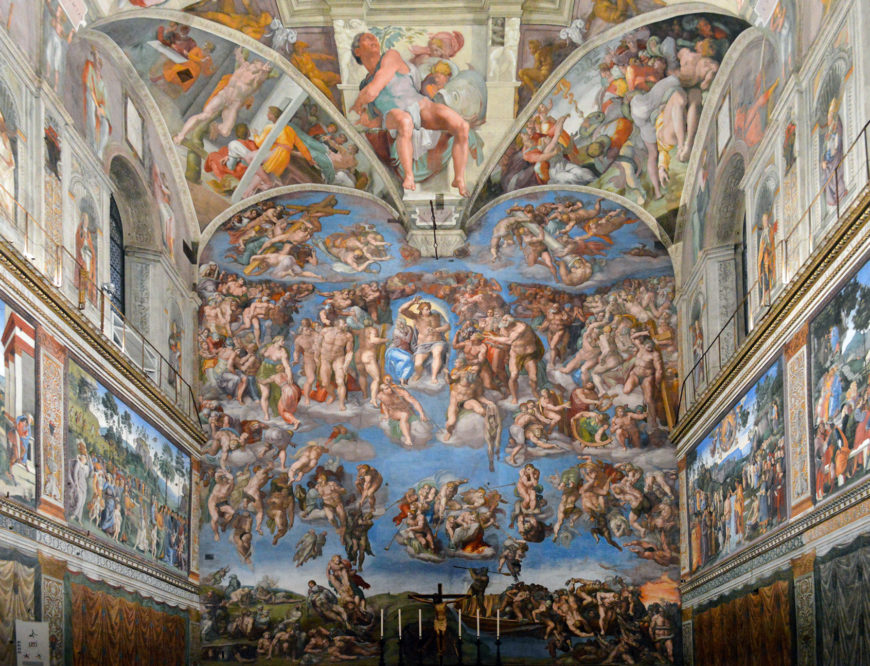
The composition
Michelangelo’s Last Judgment is among the most powerful renditions of this moment in the history of Christian art. Over 300 muscular figures, in an infinite variety of dynamic poses, fill the wall to its edges. Unlike the scenes on the walls and the ceiling, the Last Judgment is not bound by a painted border. It is all encompassing and expands beyond the viewer’s field of vision. Unlike other sacred narratives, which portray events of the past, this one implicates the viewer. It has yet to happen and when it does, the viewer will be among those whose fate is determined.
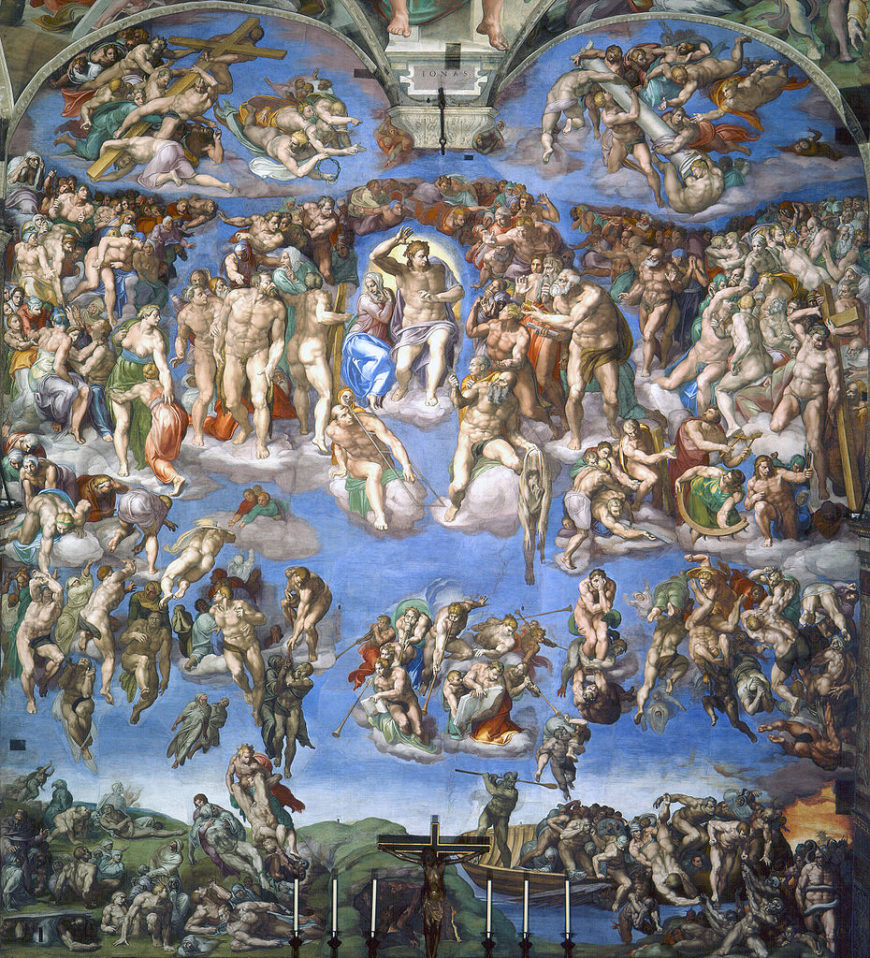
Christ is the fulcrum of this complex composition. A powerful, muscular figure, he steps forward in a twisting gesture that sets in motion the final sorting of souls (the damned on his left, and the blessed on his right). Nestled under his raised arm is the Virgin Mary. Michelangelo changed her pose from one of open-armed pleading on humanity’s behalf seen in a preparatory drawing to one of acquiescence to Christ’s judgment. The time for intercession is over. Judgment has been passed.
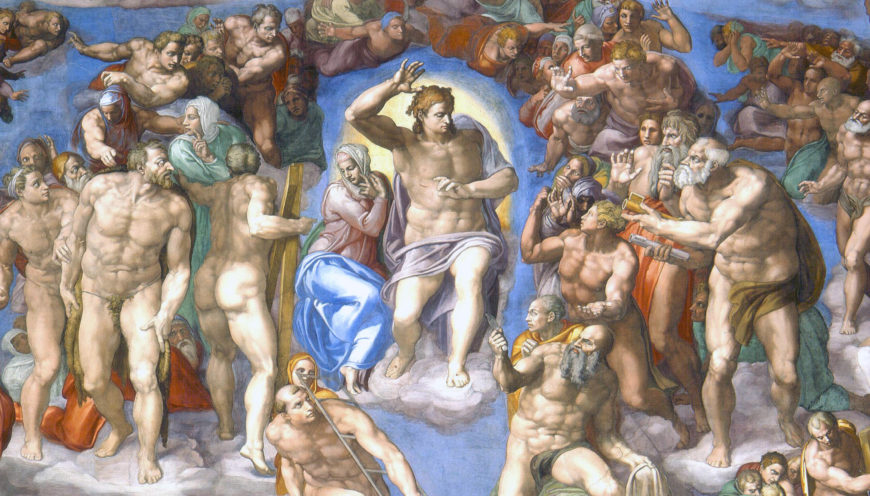
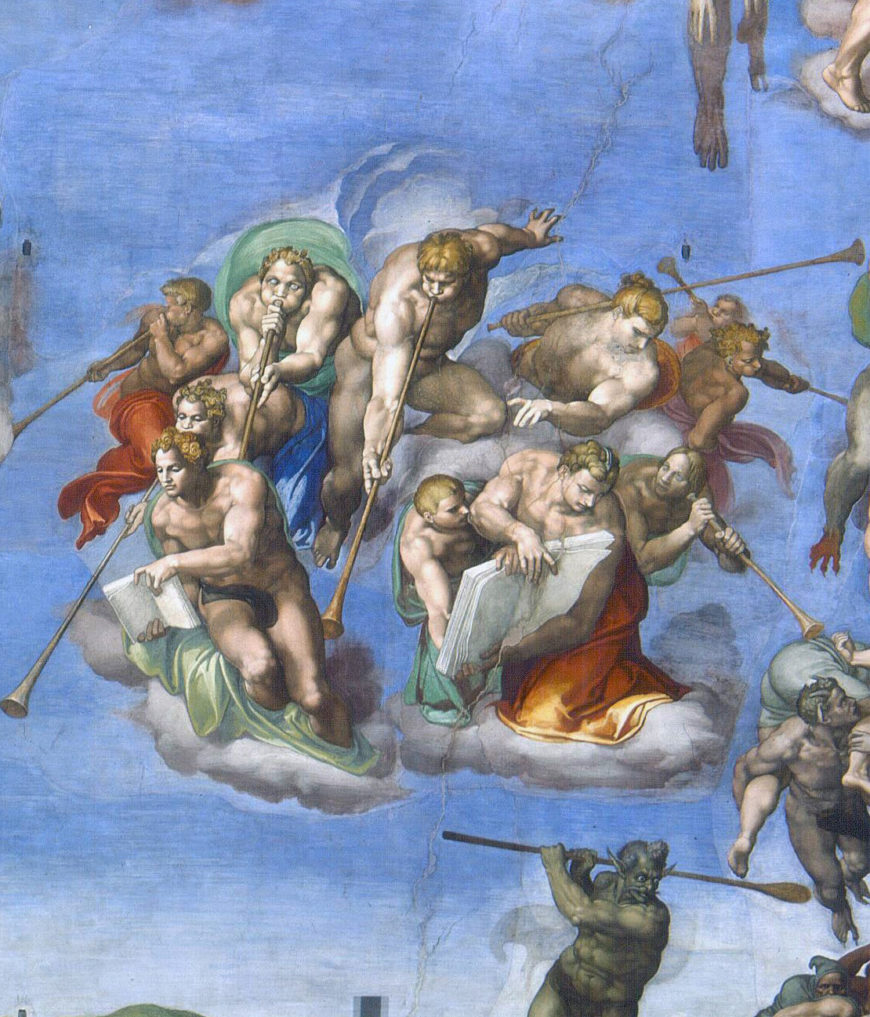
Directly below Christ a group of wingless angels (left), their cheeks puffed with effort, sound the trumpets that call the dead to rise, while two others hold open the books recording the deeds of the resurrected. The angel with the book of the damned emphatically angles its down to show the damned that their fate is justly based on their misdeeds.
The elect (those going to heaven)
On the lower left of the composition (Christ’s right), the dead emerge from their graves, shedding their burial shrouds. Some rise up effortlessly, drawn by an invisible force, while others are assisted by herculean angels, one of whom lifts a pair of souls that cling to a strand of rosary beads. This detail reaffirms a doctrine contested by the Protestants: that prayer and good works, and not just faith and divine grace, play a role in determining one’s fate in the afterlife. Directly below, a risen body is caught in violent tug of war, pulled on one end by two angels and on the other by a horned demon who has escaped through a crevice in the central mound. This breach in the earth provides a glimpse of the fires of hell.
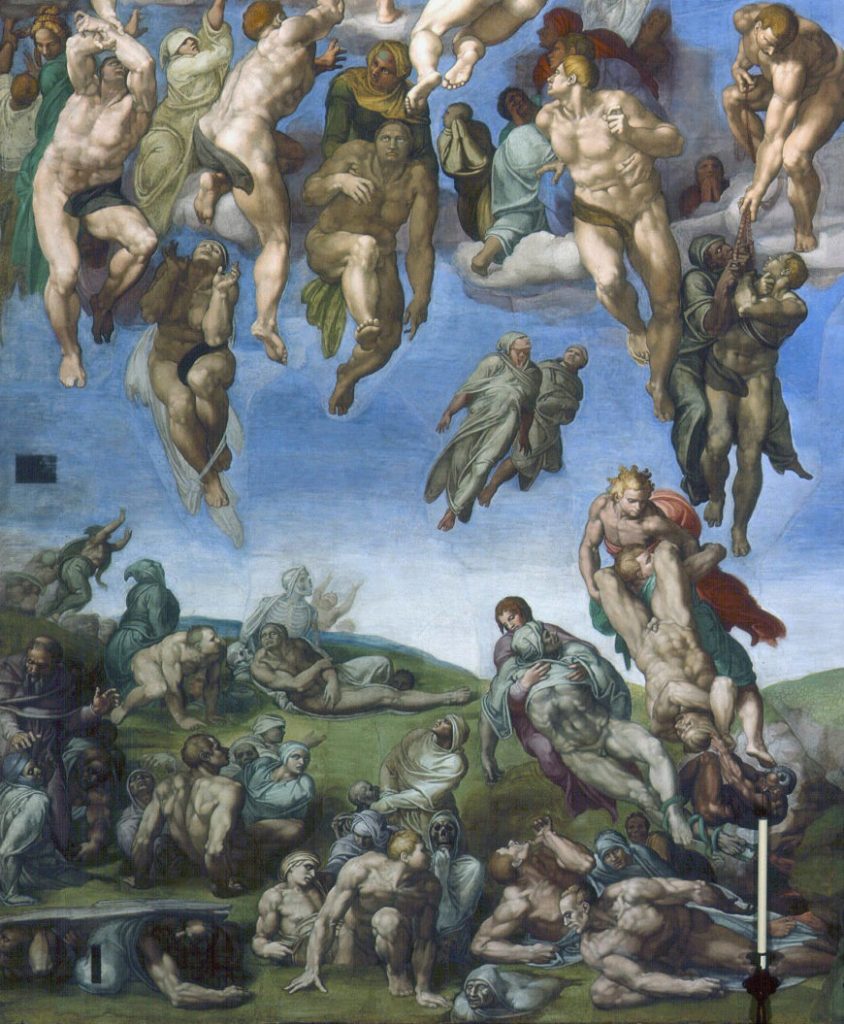
The damned (those going to hell)
On the right of the composition (Christ’s left), demons drag the damned to hell, while angels beat down those who struggle to escape their fate (image above). One soul is both pummeled by an angel and dragged by a demon, head first; a money bag and two keys dangles from his chest. His is the sin of avarice. Another soul—exemplifying the sin of pride—dares to fight back, arrogantly contesting divine judgment, while a third (at the far right) is pulled by his scrotum (his sin was lust). These sins were specifically singled out in sermons delivered to the papal court.
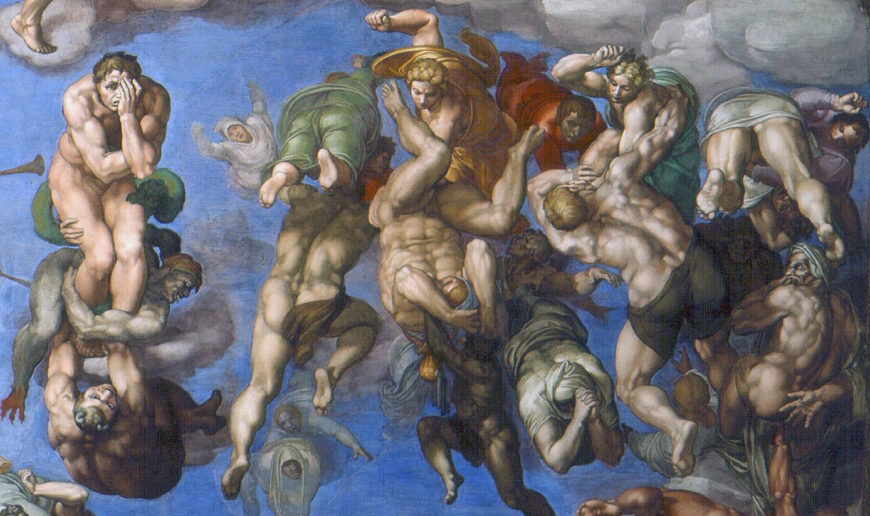
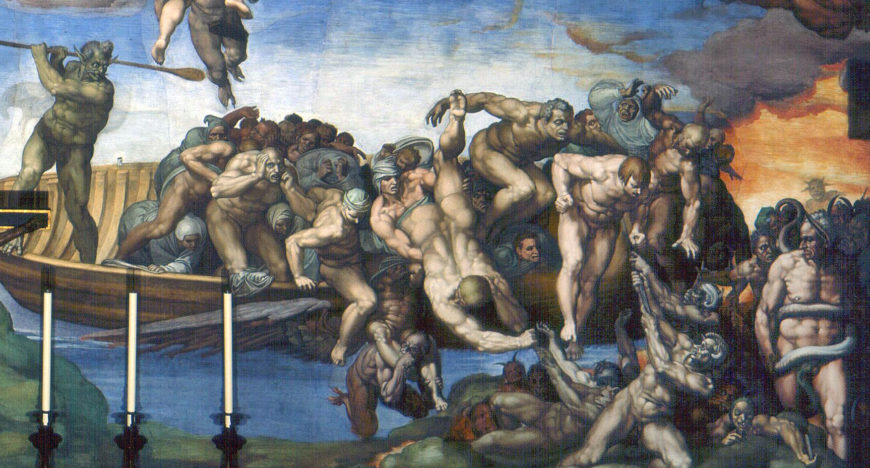
In the lower right corner, Charon—the ferryman from Greek mythology who transports souls to the underworld—swings his oar as he drives the damned onto hell’s shores (image above). In the lower right corner stands another mythological character, the ass-eared Minos, his own carnal sinfulness indicated by the snake that bites his genitals. He stands at the very edge of hell, judging the new-comers to determine their eternal punishment.
Critical response: masterpiece or scandal?
Shortly after its unveiling in 1541, the Roman agent of Cardinal Gonzaga of Mantua reported: “The work is of such beauty that your excellency can imagine that there is no lack of those who condemn it. . . . [T]o my mind it is a work unlike any other to be seen anywhere.” Many praised the work as a masterpiece. They saw Michelangelo’s distinct figural style, with its complex poses, extreme foreshortening, and powerful (some might say excessive) musculature, as worthy of both the subject matter and the location. The sheer physicality of these muscular nudes affirmed the Catholic doctrine of bodily resurrection (that on the day of judgment, the dead would rise in their bodies, not as incorporeal souls).
Others were scandalized—above all by the nudity—despite its theological accuracy, for the resurrected would enter heaven not clothed but nude, as created by God. Critics also objected to the contorted poses (some resulting in the indecorous presentation of buttocks), the breaks with pictorial tradition (the beardless Christ, the wingless angels), and the appearance of mythology (the figures of Charon and Minos) in a scene portraying sacred history. Critics saw these embellishments as distractions from the fresco’s spiritual message. They accused Michelangelo of caring more about showing off his creative abilities than portraying sacred truth with clarity and decorum. Religious art was the “book of the illiterate” and as such should be easy to understand.
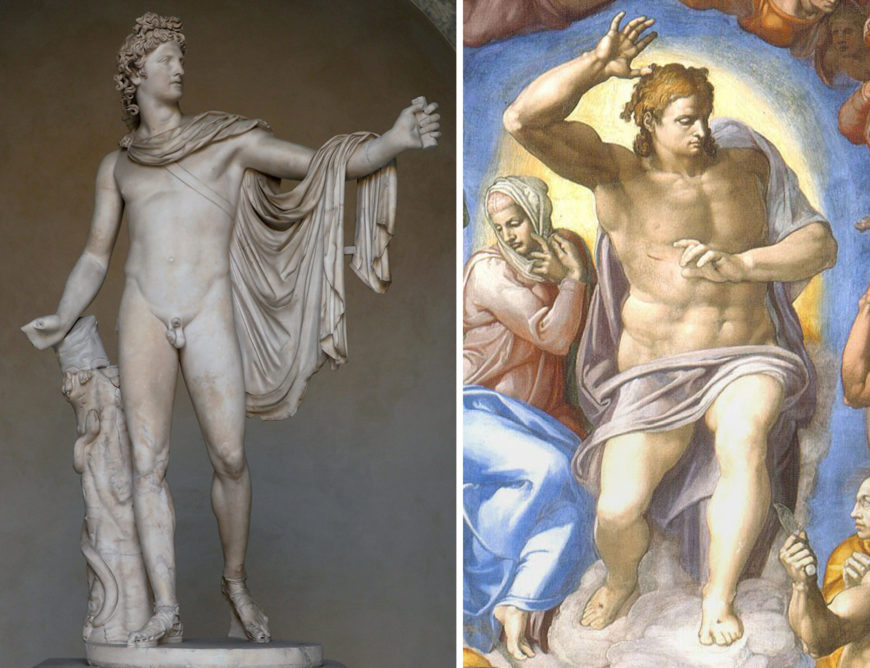
Michelangelo’s Last Judgment, however, was not painted for an unlearned, lay audience. To the contrary, it was designed for a very specific, elite and erudite audience. This audience would understand and appreciate his figural style and iconographic innovations. They would recognize, for example, that his inclusion of Charon and Minos was inspired by Dante’s Inferno, a text Michelangelo greatly admired. They would see in the youthful face of Christ his reference to the Apollo Belvedere, an ancient Greek Hellenistic sculpture in the papal collection lauded for its ideal beauty. Thus, Michelangelo glosses the identity of Christ as the “Sun of Righteousness” (Malachi 4:2).
A self-portrait
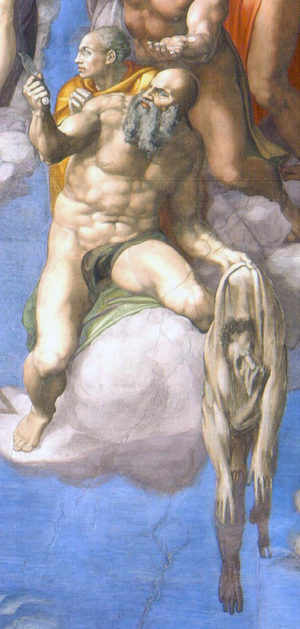
Even more poignant is Michelangelo’s insertion of himself into the fresco. His is the face on the flayed skin held by St. Bartholomew, an empty shell that hangs precariously between heaven and hell. To his learned audience, the flayed skin would bring to mind not only the circumstances of the saint’s martyrdom but also the flaying of Marsyas by Apollo. In his foolish arrogance, Marsyas challenged Apollo to a musical contest, believing his skill could surpass that of the god of music himself. His punishment for such hubris was to be flayed alive. That Michelangelo should identify with Marsyas is not surprising. His contemporaries had dubbed him the “divine” Michelangelo for his ability to rival God himself in giving form to the ideal body. Often he lamented his youthful pride, which had led him to focus on the beauty of art rather than the salvation of his soul. So, here, in a work done in his mid sixties, he acknowledges his sin and expresses his hope that Christ, unlike Apollo, will have mercy upon him and welcome him into the company of the elect.[1]
- Dr. Esperança Camara, "Michelangelo, Last Judgment, Sistine Chapel," in Smarthistory, November 28, 2015, accessed March 9, 2023, https://smarthistory.org/michelangelo-last-judgment/. ↵

